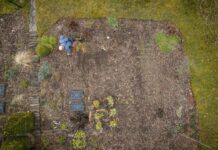While the modern-day suburban American dream can look quite a bit different from how it used to, as Millenials and the generations following them are finding it more and more difficult to own their own homes, one thing has stayed constant: the desire to live in, if not own, a beautiful property. Fortunately, that is an attainable goal for people who live in all sorts of dwellings, whether you own the two-story house with the white picket fence of legend or are renting a studio apartment in a rent-controlled complex.
Putting aside the concept of curb appeal, as that’s rarely a factor within the control of people living in apartments, the fastest way to beautify your property is to grow your own garden. It’s possible you’ve discovered this already, as the pandemic forced people to get crafty just to avoid boredom within the confines of their home and hundreds of Americans discovered the joys of gardening. But for those who haven’t, or for those who are newer to the hobby, you might be wondering where you should start.
Luckily, you happen to be in the right place. Here are a few essential tips for people looking to start growing their own garden.
Planning Your Gardening Space
You should plan to put your garden in a space where the plants you seed are likely to get a lot of sunshine, and avoid shade as much as possible to maximize the chances most of your seedlings grow tall and strong. Also, avoid planting your seeds too close together to avoid making your plants compete for resources: no matter which seedling loses and dies, the real loser in that scenario is you.
When choosing plants, try to select varieties that will do well in your climate, keeping in mind how much rain you’re likely to get, the ability of your climate’s native soil to absorb water and nutrients, and other factors that will determine your plants’ likelihood of survival. Choosing disease-resistant varieties can also help you in the long run, as a variety of possible aspects can contribute to your plants becoming diseased and dying.
If transplanting plants into your garden, make sure to check their roots before leaving the store. If you notice their roots are dark and mushy, return them immediately as they’re likely diseased, and planting them will spread that disease to the rest of your garden.
Avoid Unnecessary Chemical and Herbicide Use
While a variety of chemical products advertise themselves as a quick solution to your problems, using herbicides like Roundup can not only lead to the deaths of plants you want to keep healthy but can lead to the development of severe health problems as well. While manufacturers swear by the safety of these controlled poisons, a number of lawsuits brought on by people who have developed cancer as a result of continued exposure to them would likely disagree. Not to mention the impact these chemicals have on the environment, subtly affecting the animals living in local ecosystems and bringing about significant developmental changes.
Bottom line? Pest and weed control are necessary for any garden, but use organic methods of pest control as much as possible. They’re better for you and for your garden.
Use Green Technology When Possible
Green technology exists to make agricultural pursuits easier, and there are a variety of low-cost technologies out there that can help any aspiring gardener. Drip-irrigation systems can feed your plants a steady, low-impact stream of water without your input, making the act of watering and the guesswork involved needless. Soil meters can check the water levels in the soil, making sure that your plants are getting enough water, and low-cost hydroponic gardening kits eliminate the need for soil and sunlight altogether, making growing plants indoors an easy task. If you notice you’re having reoccurrences of the same problems, don’t be afraid to look into green tech; chances are, there’s a product out there that will meet your specific needs.
A Firm Foundation For Flourishing Flora
While you may find holes in your knowledge base as you move forward with growing your own garden, there’s an abundance of resources available online and in your local department store for novice gardeners. This article will give you the foundation you need to start the work. As you move forward, ask questions where needed and put effort into raising your plants, and you’ll find that you can grow a garden most will envy.






























































